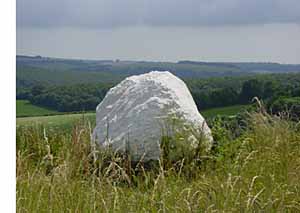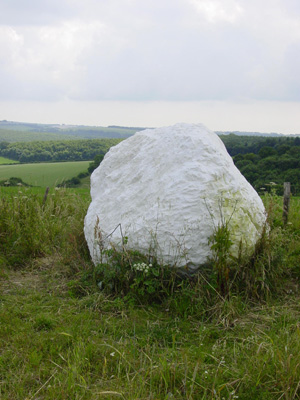The third of this month’s summer pictures shows part of an extensive “landscape intervention” by the contemporary sculptor Andy Goldsworthy. Chalk Stones Trail consists of fourteen large chalk stones excavated from a quarry in West Sussex, chiselled roughly into rounds by the artist and then placed – a little like the way-stones which once helped to guide travellers – at strategic points along a circuit of public footpaths just off the South Downs Way. Anyone wishing to encounter all 14 of Goldsworthy’s chalk stones will have to walk a route of about five miles, from the bus stop at Cocking Hill to West Dean College. Maps are available from Pallant House Gallery in nearby Chichester, where Goldsworthy’s project was initiated. The walk takes about two and a half hours – three and a half hours or more if, like me, you happen to get totally lost.
Goldsworthy is an artist who creates his sculptures exclusively from natural materials. He has worked in the past with (among other things) leaves, twigs, stones, mud, earth and ice. Many of his creations are ephemeral, some lasting for no longer than a few hours, or even minutes, and are preserved only in the form of photographs. Certain common threads run through all of his activities. He is interested in bringing out the inherent qualities of the materials with which he works, rather than going against the grain of their nature. He also likes, where he can, to enliven his audience’s responses to the places in which his sculptures are sited: to reveal overlooked aspects of the landscape, or to light upon a hidden genius loci.
 A hidden or easily overlooked aspect of the Sussex landscape was on Goldsworthy’s mind when he conceived the Chalk Stones Trail. “What fascinates me about the Sussex...
A hidden or easily overlooked aspect of the Sussex landscape was on Goldsworthy’s mind when he conceived the Chalk Stones Trail. “What fascinates me about the Sussex...


